top of page
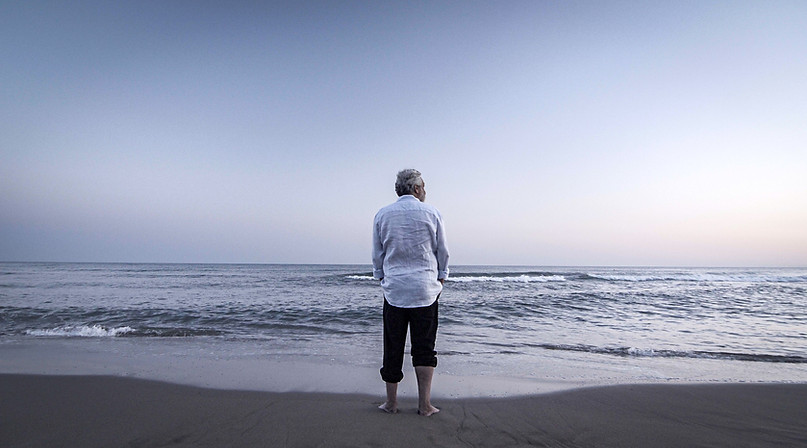
© Images by Jason Almendinger
EBI
This documentary features Ebrahim Hamedi (better known as "Ebi"), the Frank Sinatra of the Persian world. I captured him during the 50th and final year of his career. The film follows Ebi along his farewell tour, intercut between interviews retelling his life and career with those who knew him best. I wanted to share one particular aspect of the film that I created as a visual and philosophical through line of the story.
It all started with the photo below that I shot backstage during a show in Dubai. The director liked the image so much that we ended up talking about things that reminded us of its essence, like the 1972 film The Godfather. This conversation inevitably grew into the inspiration of the look for the entire film.

© Images by Jason Almendinger
THE LOOK
This is classic cinema, but at the time, The Godfather caused a tremendous rift with Paramount executives. Simply put, they hated everything about the movie, particularly the look that cinematographer, Gordon Willis, created. He was the first of his kind to really push the visuals to an extreme, which hadn't been seen before from a large studio picture. This "pushing of boundaries" was not only the definable characteristic of The Godfather, but also of Ebi himself. Ebi's politically charged music exiled him from his home in Iran during the revolution of 1979, which led him to become one of the most iconic musicians in Iranian history. With these trailblazing similarities in history, it seemed only natural to go with "The Godfather look"- plus (let's be real) it's cool.
Once the team and I agreed on the look of the documentary, I dialed in a color palette which kept our world focused. Black was a clear choice for the dramatic effect. Yellow was the representation of a classic tungsten lighting filament, which has been the standard in cinema for over 100 years. And, finally, a splash of red accent represented the Iranian flag signifying courage.

Next I re-watched The Godfather and selected this image from part II to be our base image inspiration:
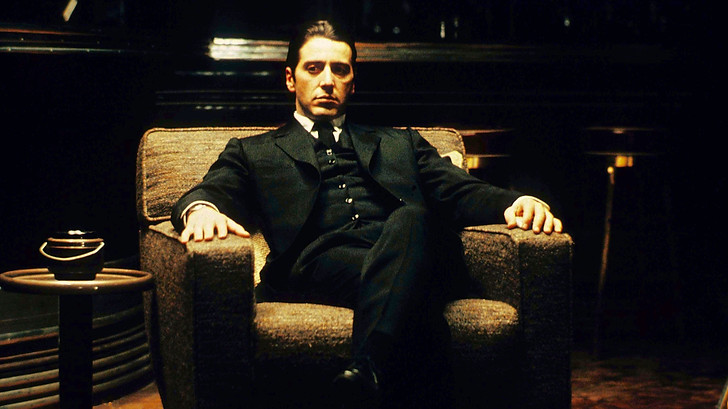
© The Godfather, part II / 1974
Below is a series of selected interviews that represents my modern interpretation of the look:
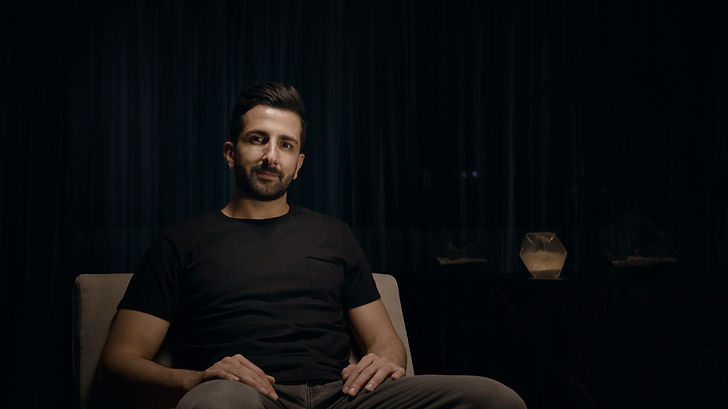
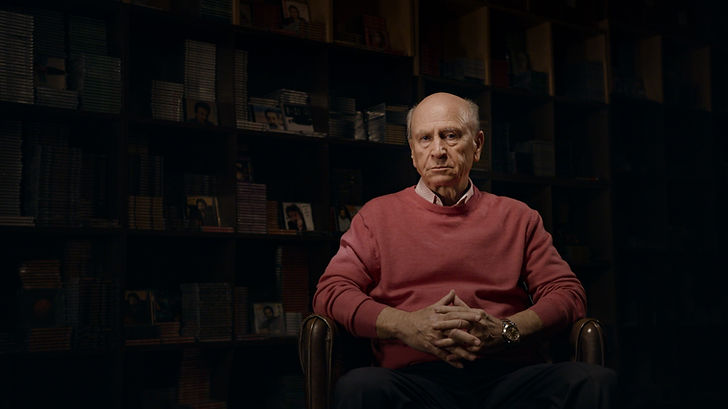


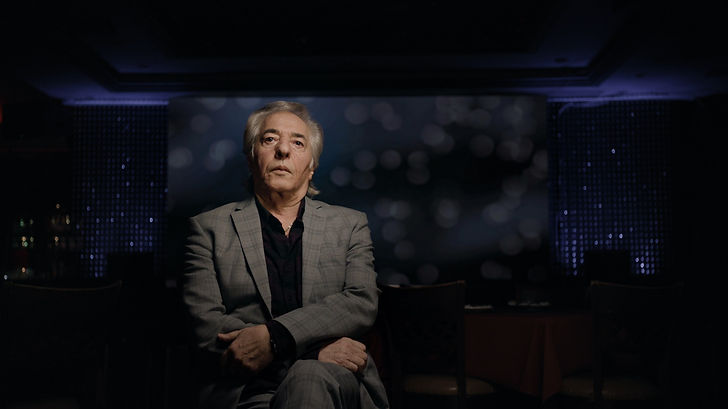
© All Images by Jason Almendinger
THE PHILOSOPHY
Generally documentary interviews can be a little stale. However, since I have a narrative-driven background I wanted to add a little more depth, especially to the "talking head" portions. The idea was to have a consistent cinematic look to create a through line for the film, but add variety to the screen through positioning and lighting of the characters. I executed this by alternating the interviewees (supporting cast) favoring the left and right third of the frame, while Ebi (our main character) was always dead center. This was meant to show the cast continuously flanking support for our main character, while also serving as a visual glorification to our protagonist.

© Images by Jason Almendinger
The kicker image is our main character, Ebi, smack dab in the middle of the frame. Here, I favored a tighter 40mm lens (on super-35mm) nudging slightly closer proximity, as opposed to a longer lens. Generally I don't like longer lenses because they flatten faces a bit too much for my taste. If I'm not limited and have full control, the longest lens I will want to use on a close-up is 40-65mm and just push closer. This focal length to me preserves the truer roundness of a person's face and feels a bit more intimate (as the camera is physically closer). This isn't a perfect science, of course, and if there is a practical or philosophical reason to shoot a longer lens I'm always open to it. But in this case, my general sentiment feels just right.
TECHNICAL
The concept for this documentary required a good amount of technical know-how in order to remain consistent across each interview. Each interview was shot months apart as well as all over the world. So with these limitations, I had to get creative with what I had available at the time. Lots of gaff tape and cardboard boxes became my personal favorites.
The main considerations needed to be repeated throughout the filming were:
- Focal length
- Camera distance/height from subject
- Lighting ratio
- Camera settings
- Composition ratio
With these in mind, I was able to take notes and repeat my process anywhere we had to capture the interviews. On these wider frames I chose a personal favorite 21mm lens (on super-35 format) with about 7 feet between the lens and the subject's chest, at just about 3 feet from the floor. I used only 3 lights.
A classic tungsten Mole Richardson 1K (1,000 watt), which is natively 3200 degree kelvin. I controlled that light with a large cardboard box clipped around it and diffused the light with 2 layers of unbleached muslin. I suspended that above the interviewee's head (at about a 45 degree angle) just outside of the top of the frame.
The second light was on the floor and I "boxed" a 650 Mole Richardson shinning through 3 layers of unbleached muslin. This light filled shadows under the eyes just enough to keep some detail in the eye- while remaining true to the look.
The third light was a small 6x6 LED panel at 3200K layered with a lot of diffusion. This light was laid on the table in front of them. This gave just a very subtle filling of any nasty unwanted shadows created in the face. With diffusion, the light warms up quite a lot getting closer to 2500 degrees kelvin, so leaving the camera at 3200 allowed that classic warmth to the image. I set the key light to about a T5.6 and set the lens to T2.0 with and ND.9 to keep my shallower depth of field. I then flagged the light spill off the chest area and the background to emphasize the face just a bit more.
The photos below show how messy and ugly the set up can be, but the results are undeniable.

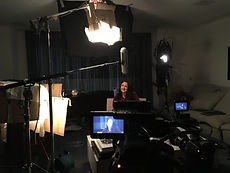

With all this said, I am hoping to communicate that when I make creative decisions, they aren't just arbitrary choices to make a pretty image. There is a much deeper web of psychological decision-making that motivates my choices. I find it important to consider the deeper use of the tools we are using; to treat our decisions with the respect of the film days as well as expand with the limitless nature of the digital age. For me motivation is everything, but on rare occasions, making things simply eye-catching can definitely be motivation enough.

© Images by Jason Almendinger
It's also important to remember that when telling human stories we want to get to know the people and embrace their lives. After 2 years with Ebi, I learned that giving kisses on the cheek were a sign of respect and affection in his culture, regardless of gender. In the States where I'm from, this is definitely not a part of the culture but that is what I love about my work. l get to enjoy learning new things, being creative, and building relationships wherever I go.


bottom of page